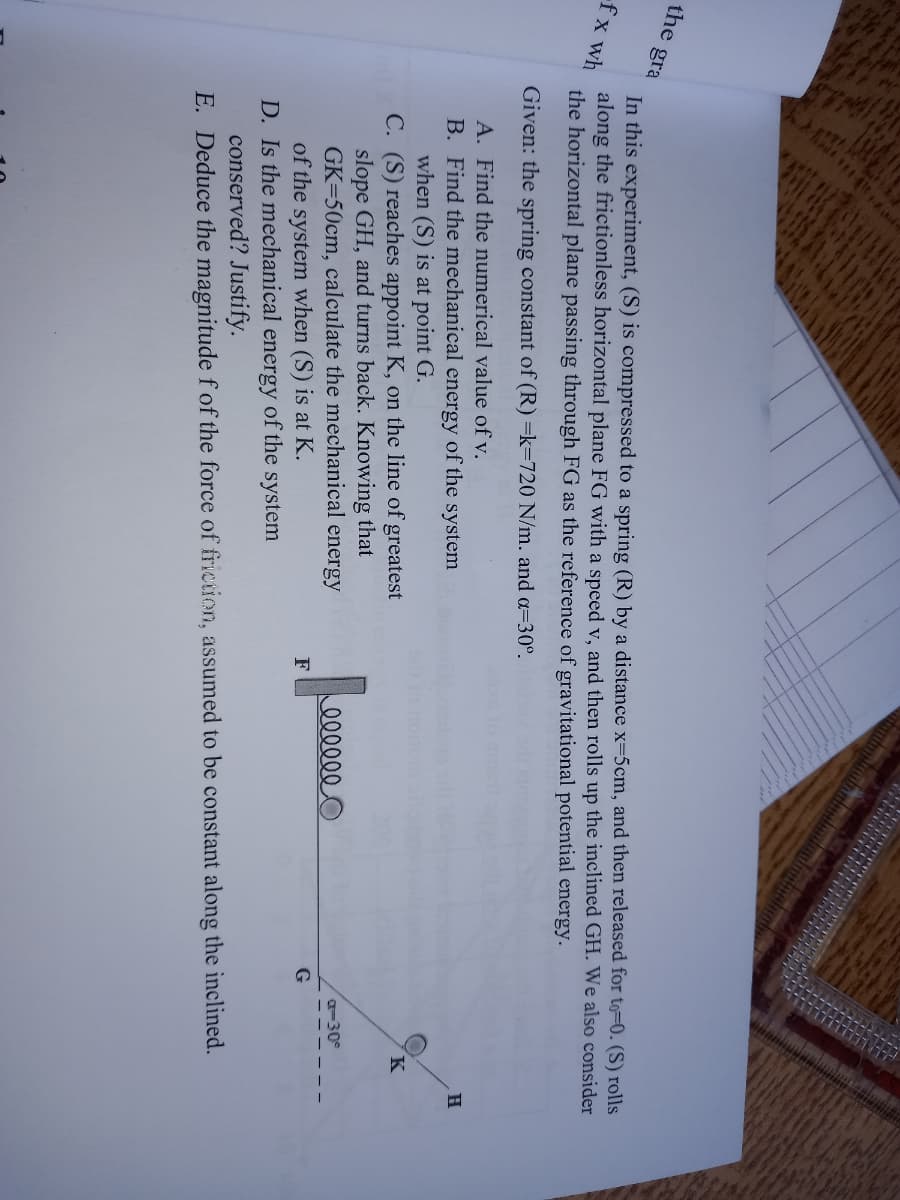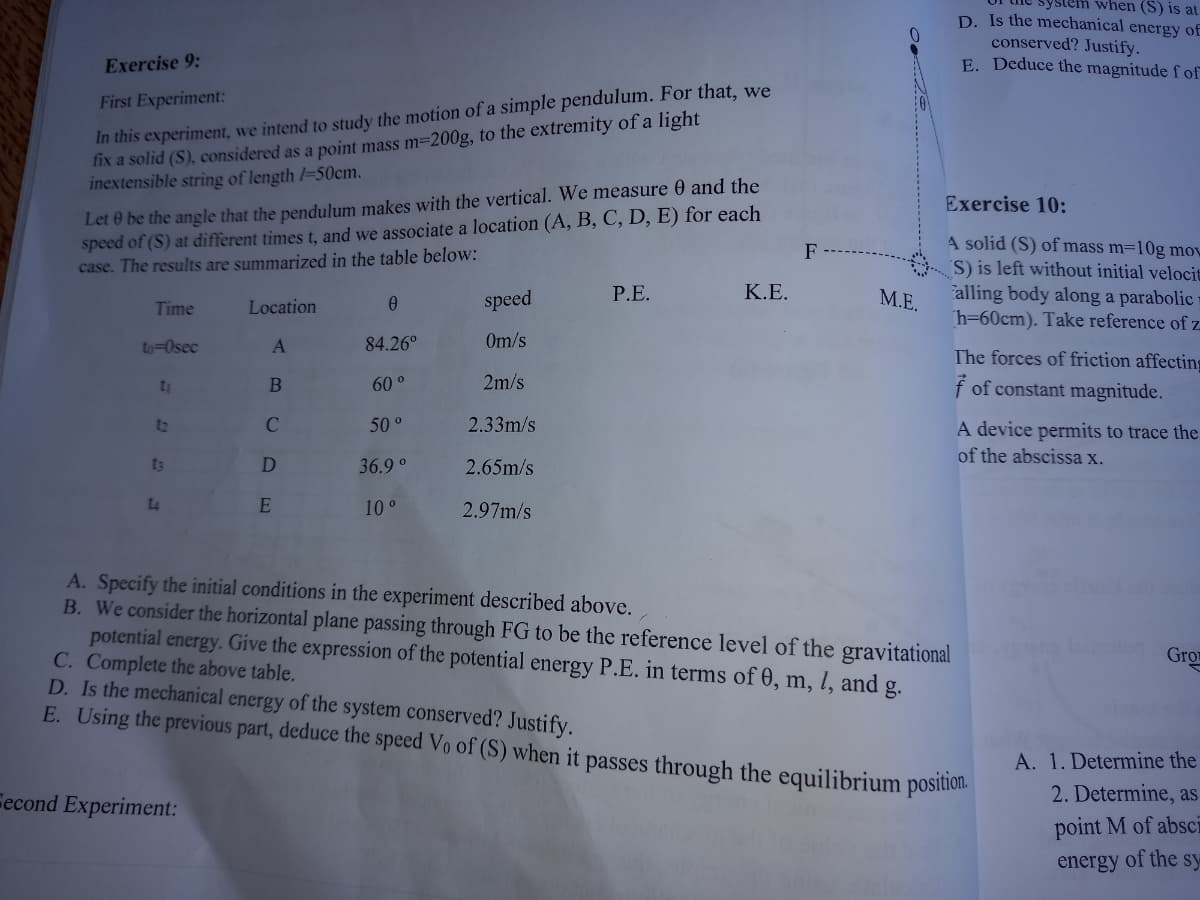In this experiment, (S) is compressed to a spring (R) by a distance x-5cm, and then released for to-0. (S) rolls along the frictionless horizontal plane FG with a speed v, and then rolls up the inclined GH. We also consider gra wh the horizontal plane passing through FG as the reference of gravitational potential energy. Given: the spring constant of (R) =k=720 N/m. and a=30°. A. Find the numerical value of v. B. Find the mechanical energy of the system when (S) is at point G. C. (S) reaches appoint K, on the line of greatest slope GH, and turns back. Knowing that GK=50cm, calculate the mechanical energy K a-30 of the system when (S) is at K. D. Is the mechanical energy of the system conserved? Justify. E. Deduce the magnitude f of the force of friction, assumed to be constant along the inclined. F G
In this experiment, (S) is compressed to a spring (R) by a distance x-5cm, and then released for to-0. (S) rolls along the frictionless horizontal plane FG with a speed v, and then rolls up the inclined GH. We also consider gra wh the horizontal plane passing through FG as the reference of gravitational potential energy. Given: the spring constant of (R) =k=720 N/m. and a=30°. A. Find the numerical value of v. B. Find the mechanical energy of the system when (S) is at point G. C. (S) reaches appoint K, on the line of greatest slope GH, and turns back. Knowing that GK=50cm, calculate the mechanical energy K a-30 of the system when (S) is at K. D. Is the mechanical energy of the system conserved? Justify. E. Deduce the magnitude f of the force of friction, assumed to be constant along the inclined. F G
Principles of Heat Transfer (Activate Learning with these NEW titles from Engineering!)
8th Edition
ISBN:9781305387102
Author:Kreith, Frank; Manglik, Raj M.
Publisher:Kreith, Frank; Manglik, Raj M.
Chapter5: Analysis Of Convection Heat Transfer
Section: Chapter Questions
Problem 5.5P: Evaluate the dimensionless groups hcD/k,UD/, and cp/k for water, n-butyl alcohol, mercury, hydrogen,...
Related questions
Question
Can u solve the whole question for me

Transcribed Image Text:the gra
In this experiment, (S) is compressed to a spring (R) by a distance x-5cm, and then released for to=0. (S) rolls
along the frictionless horizontal plane FG with a speed v, and then rolls up the inclined GH. We also consider
the horizontal plane passing through FG as the reference of gravitational potential energy.
fx wh
Given: the spring constant of (R) =k=720 N/m. and a=30°.
A. Find the numerical value of v.
H
B. Find the mechanical energy of the system
when (S) is at point G.
C. (S) reaches appoint K, on the line of greatest
slope GH, and turns back. Knowing that
GK=50cm, calculate the mechanical energy
of the system when (S) is at K.
D. Is the mechanical energy of the system
conserved? Justify.
E. Deduce the magnitude fof the force of friction, assumed to be constant along the inclined.
a-30°
000000
F

Transcribed Image Text:ystem when (S) is at
D. Is the mechanical energy of
conserved? Justify.
E. Deduce the magnitude f of
Exercise 9:
In this experiment, we intend to study the motion of a simple pendulum. For that, we
fix a solid (S), considered as a point mass m=200g, to the extremity of a light
inextensible string of length l=50cm.
First Experiment:
Let 0 be the angle that the pendulum makes with the vertical. We measure 0 and the
speed of (S) at different times t, and we associate a location (A, B, C, D, E) for each
case. The results are summarized in the table below:
Exercise 10:
A solid (S) of mass m=10g mov
S) is left without initial velocit
alling body along a parabolic
h=60cm). Take reference of z
F
speed
P.E.
K.E.
М.Е.
Time
Location
to=Osec
84.26°
Om/s
The forces of friction affecting
2m/s
f of constant magnitude.
60 °
12
50 °
2.33m/s
A device permits to trace the
of the abscissa x.
t3
36.9 °
2.65m/s
t4
10°
2.97m/s
A. Specify the initial conditions in the experiment described above.
B. We consider the horizontal plane passing through FG to be the reference level of the gravitational
potential energy. Give the expression of the potential energy P.E. in terms of 0, m, l, and
C. Complete the above table.
D. Is the mechanical energy of the system conserved? Justify.
E. Using the previous part, deduce the speed Vo of (S) when it passes through the equilibrium positioli.
nolon Gro
g.
A. 1. Determine the
Fecond Experiment:
2. Determine, as
point M of absci
energy of the sy
AB C DE
Expert Solution
This question has been solved!
Explore an expertly crafted, step-by-step solution for a thorough understanding of key concepts.
Step by step
Solved in 3 steps

Knowledge Booster
Learn more about
Need a deep-dive on the concept behind this application? Look no further. Learn more about this topic, mechanical-engineering and related others by exploring similar questions and additional content below.Recommended textbooks for you

Principles of Heat Transfer (Activate Learning wi…
Mechanical Engineering
ISBN:
9781305387102
Author:
Kreith, Frank; Manglik, Raj M.
Publisher:
Cengage Learning

Principles of Heat Transfer (Activate Learning wi…
Mechanical Engineering
ISBN:
9781305387102
Author:
Kreith, Frank; Manglik, Raj M.
Publisher:
Cengage Learning